2023.08.02.43
Files > Volume 8 > Vol 8 No 2 2023
Response of Date palm trees Phoenix dactylifera L. Khastawi cultivar to chemical, organic and biological fertilization
Elaf Hashem Mohammed Kredi1,*, Hamid Hamdan Al-Ali2
1 Department of Horticulture and Landscape Engineering, College of Agriculture, University of Anbar, Iraq .
2 Department of Horticulture and Landscape Engineering, College of Agriculture, University of Anbar, Iraq .
* Correspondance: [email protected]+
Available from: http://dx.doi.org/10.2931/RB/2023.08.02.43
ABSTRACT
This study was carried out in one of the private palm orchards located in the area of the village of Albu Assaf - Al-Dawwar, which is 10 km west of Ramadi city / Anbar Governoaverge, during the 2020-2021 season to study the effect of three levels of fertilizer combinations F0:0 ,F1: 600 g of urea (N 276) + 350 g of triple superphosphate (P2O5 500 ) + 168 g of potassium sulfate (K2O 240), 1200 g urea (552 N) + 700 g triple superphosphate (P2O5 336) + 1000 g potassium sulfate (K2O 480) and three levels of humic acid H0:0, H1:15, H2:30 ml. L-1 and two levels of a combination of biofertilizers, Trichoderma(Trichoderma harzianum) and Mycorrhizal(Glomus mosseae) B0:0, B1:300 ml Trichoderma + 400 g Mycorrhizal, with three replications for each treatment, to increase and improve the production of date palm trees, Khastawi cultiver, The research was carried out as a factorial experiment (2 x 3 x 3) it used the design of randomized complete block, RCBD, where 54 trees of 11 years of age were selected that were homogeneous in terms of growth characteristics as much as possible, Each palm was considered a repeater. The results showed the superiority of the level F2 chemical fertilization in several characteristics, including the percentage of the set fruit, the lowest percentage of fallen, the length and weight of the fruit and its size and total yield, which amounted to 52.431 kg, whereas, the control treatment gave the lowest average for the traits as mentioned earlier. The H2 level of humic acid was superior in the characteristics of the percentage of set fruit, the lowest percentage of fallen, length and weight of the fruit, its size and total yield, which amounted to 58.148. In contrast, the control treatment gave the lowest average for the abovementioned traits. The results also showed the superiority of level B1 of the combination of biofertilizers in the percentage of frozen fruit, falling, fruit length and total yield, which amounted to 51.641 kg.
In contrast, the control treatment gave the lowest rate for the abovementioned traits. The binary overlap F2H2 treatment gave the highest rates in the set fruit percentage, length and weight of the fruit, its size and the total yield, which amounted to 59,064 kg, and the lowest percentage of fallen. Also, the bilateral overlap H2B1 treatment gave the highest rates in the set fruit percentage and fruit length and the lowest percentage of fall. The same treatment with the B0 treatment appeared to outperform in the weight and size of the fruit and the total yield, which amounted to 58.915 kg compared to the control treatment that gave a lower average., the bilateral overlap F2B1 treatment gave the highest rates in the characteristics of fruit length and weight, as well as the triple overlap F2H2B1 treatment, gave the highest averages in the characteristics of the set fruit percentage and the lowest percentage of fallen and weight of the fruit and the total yield, which amounted to 59.648 kg compared to the control treatment that gave a lower average for the mentioned traits where the response was significant for the type is Khastawi in terms of increasing the yield and its components.
Keywords: Date palm; chemical fertilization; NPK; bioFertilization; Humic acid; Khastawi.
INTRODUCTION
The date palm, Phoenix dactylifera L., is one of the essential evergreen fruit trees belonging to the palm family Arecaceae, It is one of the oldest fruit trees known to man in Mesopotamia and the Nile Valley, and its cultivation spreads in the tropics between latitudes (10 and 30) north of the equator and extends to latitude 20 south of the equator 1 . Palm trees are characterized by their significant economic importance, as their fruits are of high nutritional value, as they are considered an inter gaveraged food system because they contain many sugary substances that are easily digested and absorbed by the body. They also contain many vitamins, fiber, mineral elements and proteins 2. Fertilization plays a central role in improving the growth of trees, particularly since providing the essential food for growth leads to the completion of the formation of fruits and their good growth because of the importance and role of nutrients in improving the quantity and quality of the fruits of the date palm, as indicated by the results of many studies conducted in the Arab world, chemical fertilization is considered one of the most critical processes of serving the date palm that increases production and improves its quality 3. A study conducted by 4 on three cultivars of new-fruited date palms showed that the fertilization date and cultivar had a significant effect on the amount of yield, as the Khadrawi Mandali cultivar and the fertilization date in (March, April, and September) outperformed in giving the highest amount of yield amounting to 15.67 kg. plam-1 , as for the cultivar Barhi 8.43 kg.palm-1. As for Al-Zahdi, it came in the last rank in terms of production quantity, which amounted to 6.65 kg.palm-1 .5 found that fertilizing with the fertilizer combination on Khastawi cultivar at the age of 10 years led to a significant increase in the percentage of the set fruit, weight fruit, size fruit, length fruit, diameter fruit, the weight of the total yield, which reached 42.5 kg, and the lowest falling average. The importance of Humic acid by effect on plant growth and element readiness, due to its role in increasing the permeability of the cell membrane and facilitating the activity and absorption of water and nutrients, and this helps the movement and transfer of minerals 6. 7 conducted a study that included spraying humic acid at average of 2 g L-1 on the vegetative growth and adding 4 g L-1 to the soil and K-Humate at an average of 2 g L-1 on the vegetative growth and adding 4 g L-1 to the soil And the overlap between them, as well as the control treatment of the Khestawi date variety growing in gypsum soils, It was found that the treatment of humic acid at a average of 4 g L-1 added to the soil in combination with the overlap of K-Humate at a average of 4 g L-1 to the soil gave the highest rate of fruit weight, fruit diameter and total yield, as it gave an average yield of 55.67 kg palm-1 , whilst the control treatment gave the lowest rate for the abovementioned traits, as it gave an average of 37.33 kg Palm-1. Also, biofertilizers are considered one of the essential life technologies, which increases nutrient absorption from the soil 8. At the forefront comes a group of organisms that encourage growth, including bacteria and fungi. Fungi include a group of mycorrhizae and Trichoderma fungi, which improve and encourage plant growth. Where it preserves the elements in the agricultural soil and converts them into a soluble and available form for plant nutrition 9, 10. 11 observed when they studied the effect of adding Mycorrhizae fungi and one of the compounds of a polyamine group on orange trees that the treatment of Mycorrhizal fungi achieved a positive effect in most of the studied traits, including the rate fruit size and fruit weight compared to other treatments. 12 also indicated when he studied the effect of adding Mycorrhizal fungi on palm trees of the two cultivars Al-Zahdi and Al-Ashrasi that the treatment of the Mycorrhizal fungi achieved a positive effect in most of the studied traits, as the treatment of the organic fertilizer with the bacterial and fungal fertilizers mixed gave the highest yield of (65.00, 76,500) kg palm-1 for both seasons, respectively, for the Zuhdi cultivar, while it gave (20,416, 24.916) kg palm-1 for both seasons, respectively, for the Al-Ashrasi cultivar.
MATERIALS AND METHODS
The research was carried out in one of the private orchards located in the area of the village of Al-Bu Assaf_ Al-Dawwar, which is 10 km west of the city of Ramadi, starting from 10/2/2021 until 15/9/2021 on date palm trees of the Khastawi cultivar to find out the effect of ground adding for each of the NPK fertilizer combinations, Humic acid and biofertilizers on flower characteristics and yield. Where homogeneous trees were selected in size and age (11 years), of the cultivar Khastawi cultivated by cuttings, in the form of lines, all the serving operations were carried out for it , and the number of bunches for palms within the experiment was standardized to 6 bunches. Adding NPK and humic acid chemical fertilizers was carried out on three dates, the first on 10/2, the second on 10/4 and the third on 10/6. The bio-fertilizers were added all at once on the first date only, at a depth of 60 cm. Basins with a diameter of 1.5 m were made, and the soil surface was turned deeply 5 cm around the selected palm trees to facilitate the adding process. Also, organic manure (poultry residues) was added as one of the service operations for palms, as it was added in December, at an average of 20 kg per palm 13.
Study factors
The first factor is the fertilizer combinations with three levels, which is the control treatment, and its symbol is F0.
Fertilizer combination F1
600 g of urea (N 276) + 350gm Triple Super Phosphate (P2O5 500( + 168 g potassium sulfate (K2O 240).
Fertilizer combination F2
1200 g urea (552 N) + 700 g triple superphosphate (P2O5 336) + 1000 g potassium sulfate (K2O 480) and its symbol are F2. The second factor is humic acid in three concentrations (0, 15, 30) ml. L-1 and its symbols are (H0, H1, and H2).
The third factor is a combination of biological fertilizers, Trichoderma harzianum and Mycorrhizae (Glomus mosseae), with two concentrations of 0 and (300 ml of Trichoderma + 400 g of Mycorrhizae) and its symbol is (B0, B1).
Studied traits
The percentage of set fruit %: It was calculated for all treatments in the wet stage by taking five flower stalks at random from each bunch for each palm (replicate), and the number of fruits present and the number of sites of fallen fruits (empty scars) on each flower stalk was calculated and the percentage of frozen fruit in the wet stage, as in the following equation:

The percentage of fallen%: It was calculated for all treatments in the wet stage by taking five flower stalks at random from each bunch for each palm (repeated) and the number of fruits present and the number of sites of fallen fruits (empty scars) were calculated on each flower stalk, and the percentage of fallen in the wet stage, as in the following equation:

Fruit length (cm)
Sixteen fruits were selected from each replicator, and their length was measured using (Vernier), and the average was extracted by dividing the total by the number of fruits.
Fruit size (cm3)
The average fruit size was calculated using the water displacement method for the fruits whose weight was measured before removing the kernels through a graduated cylinder, where the water was placed in it to a certain extent. When adding the fruits, the water was moved up, and the reading value was taken on the cylinder, then, the average size of one fruit was extracted by dividing the volume of water. Joking on the number of fruits 16.
Fruit weight (g)
Fruit weight was calculated randomly, as the weights of sixteen fruits were calculated from each replicator and weighed using a sensitive balance; then, the average was extracted by dividing the weight of the fruits by the total number of fruits.
Total yield (kg palm-1)
After harvesting the fruits for each palm sepa, averagely, it was weighed by a field scale, and then the average weight of the total yield for each treatment was extracted.
RESULTS
The effect of chemical, organic and biological fertilization and the overlap between them in the percentage of set fruit (%) of date palm Khastawi .cv
Table 1 shows the significant effect of chemical fertilization treatments on the contraction percentage, as the F2 treatment gave the highest set fruit percentage of 74.246%, while the control treatment awarded the lowest set fruit percentage of 65.877%; the results showed that there were significant differences as an effect of the adding of humic acid, as the H2 treatment gave the highest set fruit percentage of 76.427%, while the control treatment gave the lowest contract percentage of 61.249%, the results showed that there were significant differences for the biological fertilization, as the treatment B1 gave the highest percentage of the contract amounting to 71.941%, while the control treatment gave the lowest contract percentage of 68.795%. The table results indicated significant differences in the percentage of the contract due to the overlap of a combination fertilizer and humic acid as the treatment F2H2 excelled, as it gave the highest percentage of 78.290%. In comparison, the control treatment gave the lowest percentage of 50.753%. The results of the table showed that there were significant differences in the percentage of the set fruit as a result of an overlap between chemical and biological fertilization, as treatment F1B1 gave the highest percentage of 75.452%, while treatment F0B1 gave the lowest percentage of 65.319%. The results of the table indicated that there were significant differences in the percentage of set fruit as a result of the overlap of humic acid and biofertilization, as the H2B1 treatment gave the highest set fruit percentage of 76.640%, while the H0B1 treatment gave the lowest percentage of 57.333%. The table results indicated no significant differences for the overlap of fertilizer combinations, humic acid and biofertilization in the percentage of set fruit.
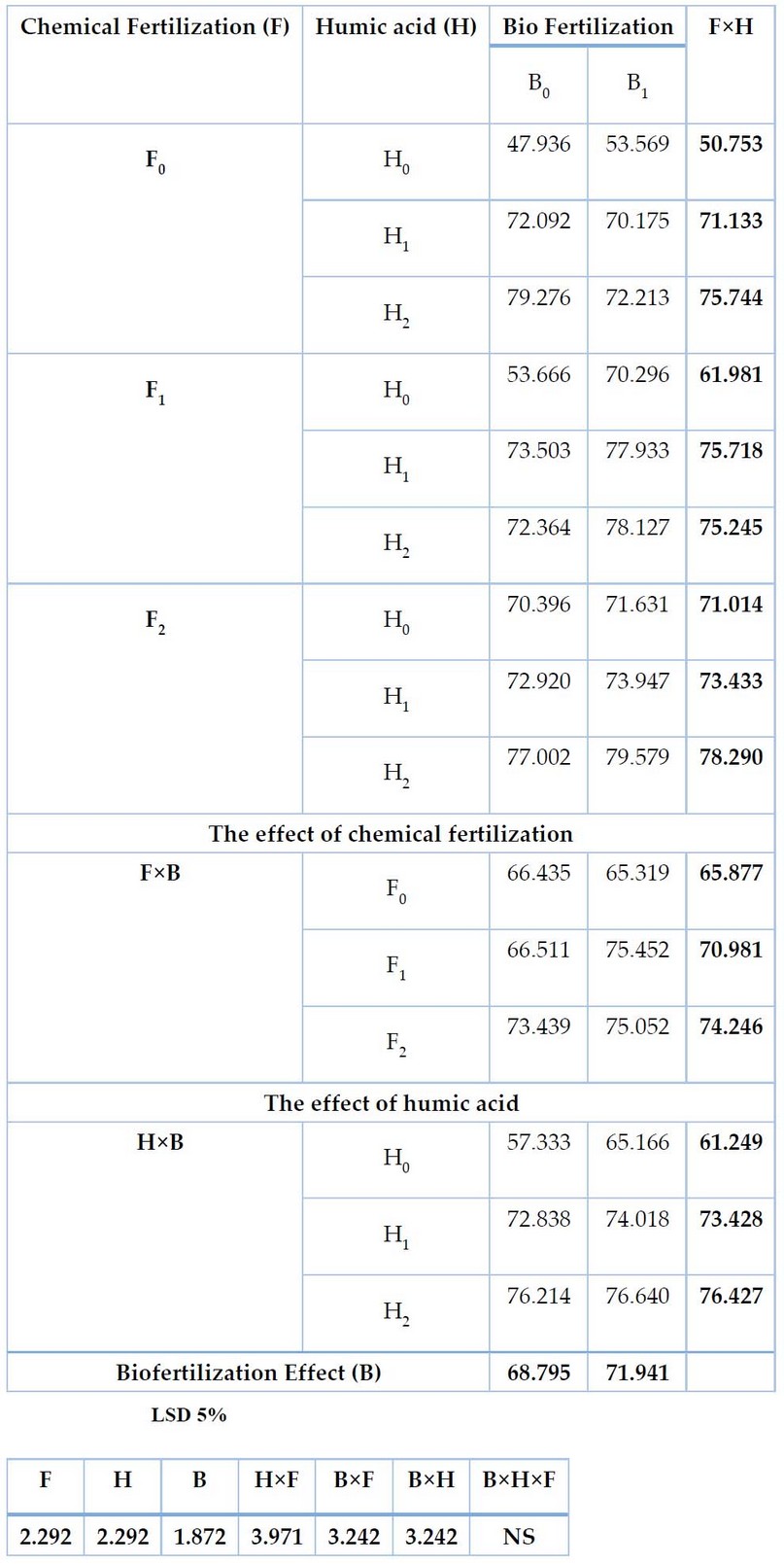
Table 1. The effect of chemical, organic and biological fertilization and the overlap between them on the percentage of set fruit (%) of date palm Khastawi .cv
The effect of chemical, organic and biological fertilization and the "overlap between them on the percentage" of fallen (%)date palm Khastawi .cv
Table 2 shows the significant effect of chemical fertilization treatments on the fallen percentage, as the F2 treatment gave the lowest fallen percentage of 25.29%, while the control treatment gave the highest fallen percentage of 33.10%; the results presented that there were significant differences" for humic acid, as the H2 treatment gave the lowest fallen percentage of 22.68%, while the control treatment gave the highest fallen percentage of 38.17%. The results showed significant differences for biological fertilization, "as treatment B1 gave the" lowest fallen percentage of 27.02%, whilst the control treatment gave the highest fallen percentage of 30.44%, the results of the table indicated that there were significant differences in the percentage of fallen as a result of the overlap of fertilizer combination and humic acid , the treatment F2H2 gave the lowest fallen percentage of 22.19% ,whilst the control treatment gave the highest percentage of 49.01%, and the results of the table showed that there were significant differences in the percentage of fallen as a result of the overlap of chemical and biological fertilization, as the treatment F1B1 reached the lowest fallen percentage of 22.80%, whilst the treatment F0B1 gave the highest percentage of 33.13%, the effects of the table indicated that there were significant differences in fallen percentage a result of the overlap of humic acid and biofertilization, as the H2B1 treatment reached the lowest fallen percentage of 21.78%, whilst the treatment H0B0 gave the highest fallen percentage of 42.91%,the results of the table indicated that there were significant differences in the percentage of fallen as a result of the overlap of fertilizer combinations, humic acid and biological fertilization. The treatment F2H2B1 gave the lowest fallen percentage of 20.62%, while the control treatment gave the highest fallen percentage of 53.02%.
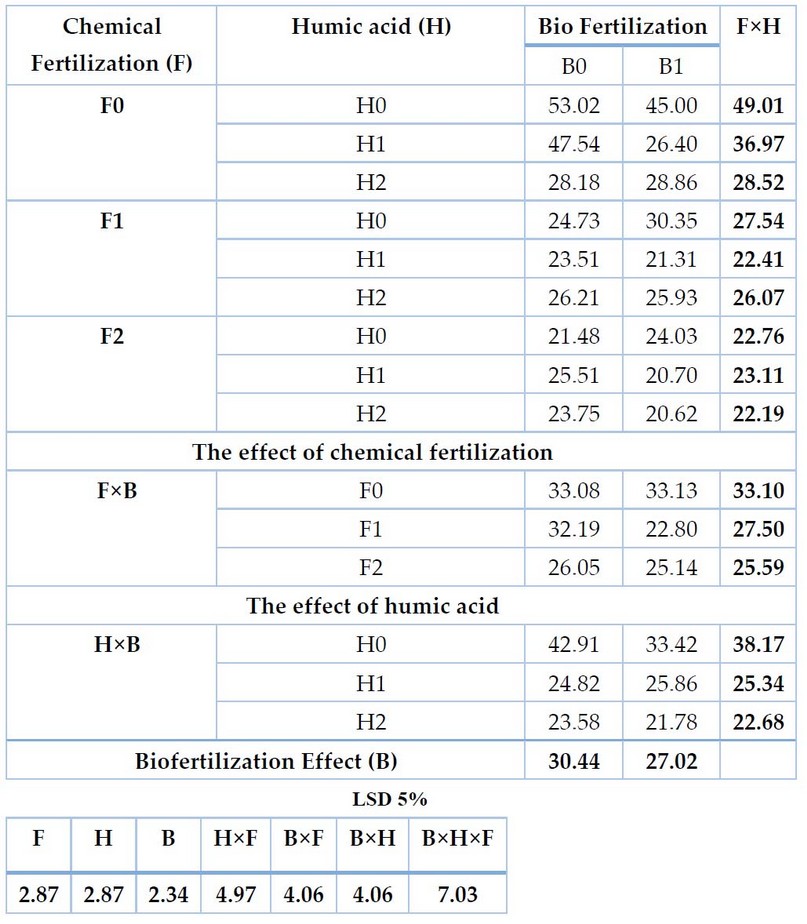
Table 2. Effect of chemical, organic and biological fertilization and the overlap between them on the percentage of fallen (%)date palm Khastawi .cv
The effect of chemical, organic and biological fertilization and the overlap between them on the average fruit length (cm) of date palm Khastawi .cv
Table 3 shows the significant effect of chemical fertilization treatments on the average fruit length, "as F2 gave the highest average" of 2.941 cm. In comparison, the control treatment gave the lowest average of 2.764 cm. The results showed significant differences for humic acid, as the H2 treatment gave the highest average of 3.159 cm. In comparison, the control treatment gave the lowest rate of 2.434 cm. The results showed significant differences for biological fertilization, as treatment B1 gave the highest average of 2.905 cm, while the control treatment gave the lowest rate of 2.775 cm. The table results indicated "that there were significant differences in the average" length of the fruit due to the overlap of fertilizer combination and humic acid, as the F2H2 treatment gave the highest average of 3.345 cm.
In comparison, the control treatment gave the lowest average of 2.387 cm. The table results showed significant differences in the average length of the fruit "as a result of the" overlap of chemical and biological fertilization, as the treatment F2B1 reached the highest average of 3.023 cm. In comparison, the treatment F1B0 gave the lowest average of 2.683 cm. The results of the table indicated significant differences in the rate of fruit length "due to the" overlap of humic acid and biofertilization, as the H2B1 treatment reached the highest average of 3.175 cm. In comparison, the control treatment gave the lowest rate of 2.393 cm. The results of the table indicated that there were significant differences in the average length of the fruit as a result of the overlap of fertilizer combinations, humic acid and biological fertilization, as the F2H2B1 treatment gave the highest rate of 3.382 cm, while the control treatment gave the lowest average of 2.353 cm.
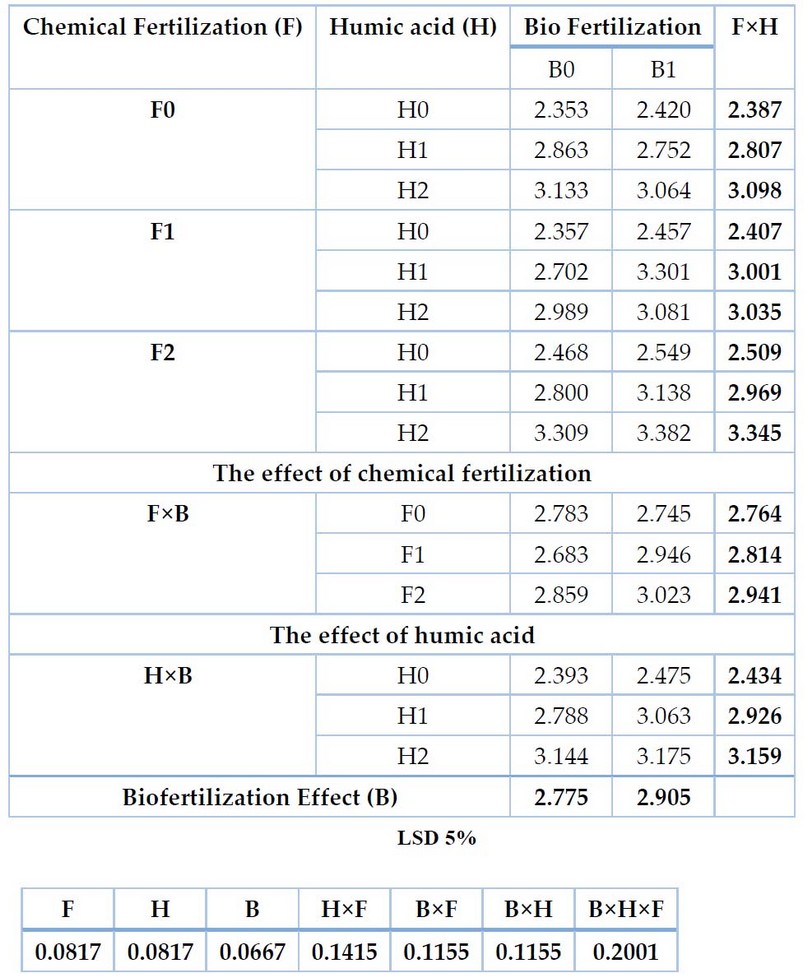
Table 3. The effect of chemical, organic and biological fertilization and the overlap between them on the average fruit length (cm) of date palm Khastawi .cv
The effect of chemical, organic and biological fertilization and the overlap between them on the average fruit size (cm3) for date palm .cv Khastawi
Table 4 shows the significant effect of chemical fertilization treatments on the average fruit size, as the F2 "treatment gave the highest average" of 7.157 cm3. The control "treatment gave the lowest average" of 6.180 cm3. The results showed significant differences for humic acid, as the H2 treatment gave the highest average of 7.275 cm3, while the control treatment gave the lowest average of 5.806 cm3, but the effect of biological fertilization was not significant; the results of the table indicated that there were significant differences in the average fruit size as a result of the overlap of fertilizer combination and humic acid, as the F2H2 treatment gave the highest average of 8.065 cm3. In comparison, the control treatment gave the lowest average of 5.225 cm3. "The results of the table showed that there were significant differences in the average fruit size as a result of the overlap of chemical and biological fertilization, as the treatment F2B0 reached the highest average of 7.216 cm3, while the control gave the lowest average of 5.957 cm3. The results of the table showed that there were significant differences in the average fruit size as a result of the overlap of humic acid and biofertilization, as the H2B0 treatment reached the highest average of 7.442 cm3, while the control treatment gave the lowest average of 5.567 cm3. The table results showed significant differences in the average fruit size" due to the overlap of fertilizer combinations, humic acid and biofertilization, as the two treatments, F2H2B0 gave the highest average of 8.180 cm3. In contrast, the control treatment gave the lowest average of 4.526 cm3.
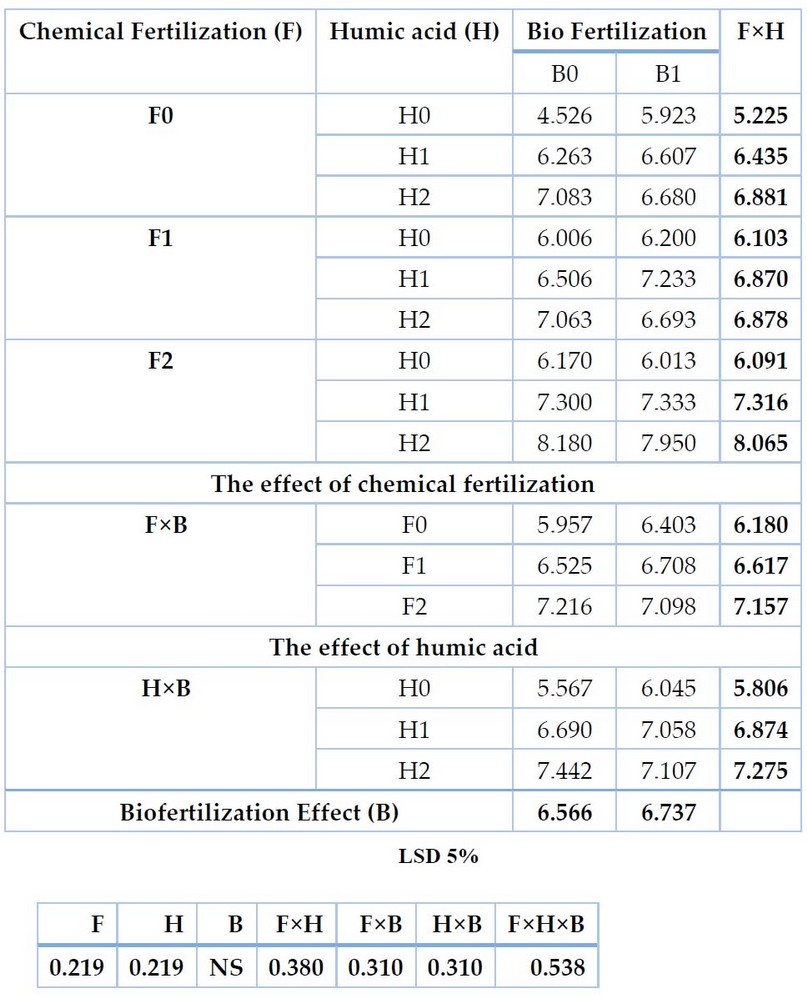
Table 4. The effect of chemical, organic and biological fertilization and the overlap between them on the average fruit size (cm3) for date palm Khastawi .cv
The effect of chemical, organic and biological fertilization and the overlap between them on the average fruit weight (g) of date palm Khastawi .cv
Table 5 shows the significant effect of chemical fertilization treatments on the average fruit weight, "as the F2 treatment gave the highest average" of 7.268 g. The comparison treatment gave the lowest rate of 6.283 g, and the results showed significant differences for humic acid, as the H2 treatment gave the highest average of 7.736 g. In comparison, the control treatment gave the lowest average of 6.188 g, but the effect of biological fertilization was insignificant. The table results showed significant differences in the" average weight of the fruit as a result of the overlap of fertilizer combination and humic acid, as the F2H2 "treatment gave the highest average" of 8.940 g. In comparison, the control treatment gave the lowest average of 5.648 g. The results of the table showed that there were no significant differences in the average weight of the fruit as a result of the overlap of chemical and biological fertilization, the results of the table showed that there were significant differences in the average weight of the fruit as a result of the overlap of humic acid and biofertilization, where the treatment H2B0 gave the highest average of 7.880 g. In comparison, the control treatment gave the lowest average of 6.112 g, and the results of the table indicated that there were significant differences in the average weight of the fruit as a result of the overlap of fertilizer combinations, humic acid and biological fertilization, as the F2H2B1 treatment gave the highest average of 9.113 g. In comparison, the control treatment gave the lowest average of 5.133 g.
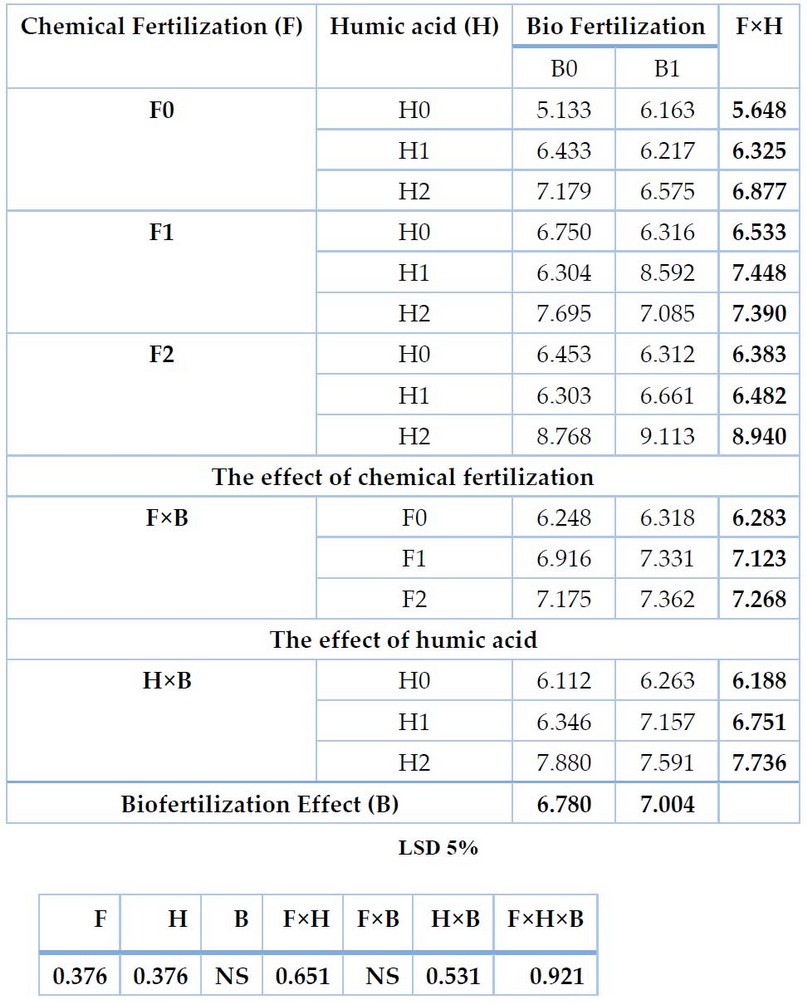
Table 5. The effect of chemical," organic and biological fertilization and the overlap between them on the average fruit weight (g) of date palm Khastawi .cv
The effect of chemical, organic and biological fertilization and the overlap between them on the total yield of the palm (kg) of date palm Khastawi .cv
Table 6 shows the significant effect of chemical fertilization treatments on the average weight of the total yield, as the F2 treatment gave the highest yield average of 52,431 kg . The control treatment gave the lowest yield average of 48,399 kg . The results showed significant differences for humic acid, as the H2 treatment gave the highest yield average of 58.148 kg , while the control treatment gave the lowest yield average of 39.508 kg . The results showed that there were significant differences for biological fertilization, as treatment B1 gave the highest yield average of 51,641 kg , while the comparison treatment gave the lowest yield rate of 49.005 kg ," the results of the table indicated that there were significant variances as a result of the" overlap of fertilizer combination and humic acid in the weight of the total yield, as the F2H2 treatment gave the highest yield average of 59,064 kg . In comparison, the control treatment gave the lowest average of 34.487 kg ; the results of the table showed that there were no significant differences in the total yield as a result of the overlap of chemical and biological fertilization, the results of the table showed that there were significant differences in the total yield as a result of the overlap of humic acid and biofertilization, where the H2B0 treatment gave the highest average yield of 58.915 kg , while the control treatment gave the lowest yield average of 36,700 kg . No significant differences in the total yield were due to the overlap of fertilizer combinations, humic acid and biological fertilization.
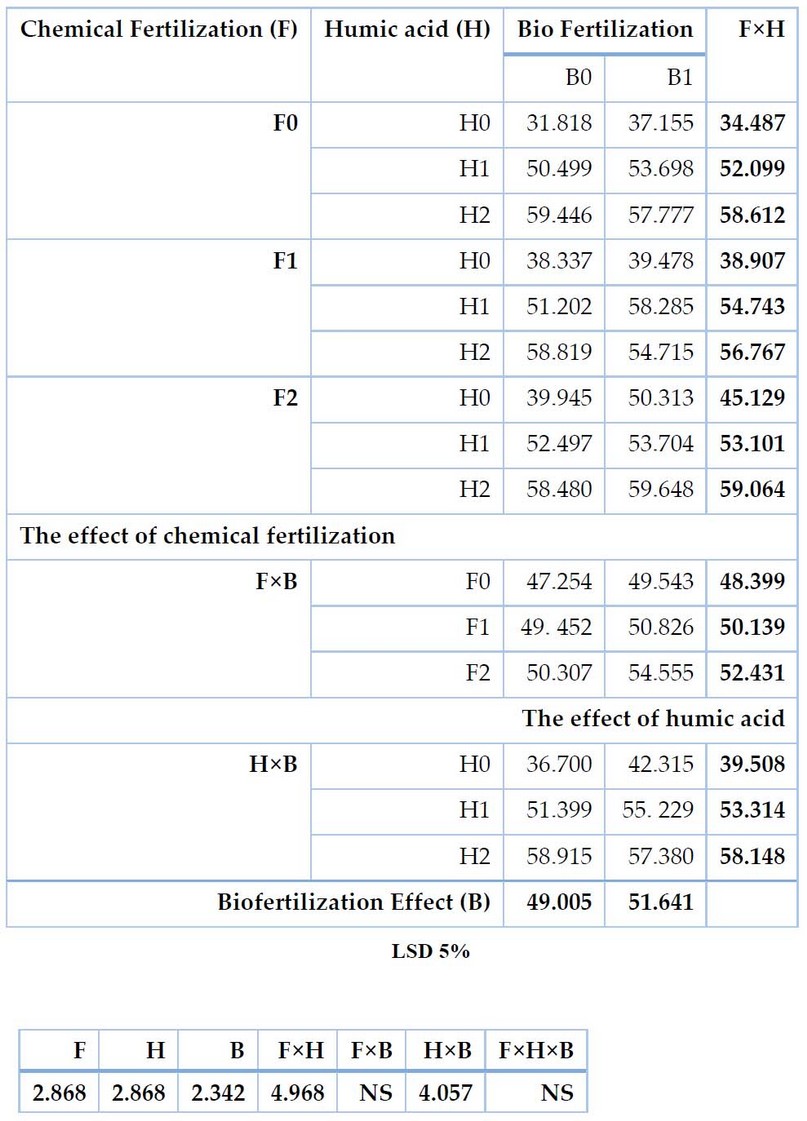
Table 6. Effect of chemical, organic and biological fertilization and the overlap between them on the total yield of the palm (kg) of date palm Khastawi.cv
DISCUSSION
The increase in the productivity of fruits when increasing the levels of mineral fertilizer NPK is due to the effect of this fertilizer in increasing the percentage of fruit set and reducing the fall of fruits as in Tables (1 and 2) and increasing their weight, which occurred due to the role of the elements in increasing the floral induction and the formation of the principles of flowers and the maintenance of the vitality of flowers and fruits, which reduces the falling out, Nitrogen is included in the formation of amino acids as well as in the synthesis of nucleic acids, proteins and other organic compounds in the living cell, as well as its role in the manufacture of hormones such as auxins and cytokinins that regulate vital processes in plants and encourage the growth of flower buds. Auxins also inhibit the action of ABA in stimulating the formation of the separation area. As for phosphorous, it stimulates cell division and forms energy compound formation 14. Although potassium is not included in the composition of organic compounds, its role stabilizes acidity, and PH, and osmotic regulation is necessary for enzymatic activation and transport processes in membranes 15. Also, the reduction in precipitation may be attributed to the fact that the increase in the concentrations of N, P, and K during the different stages of growth and maturity led to a state of activity and rapid growth of the fruit tissues due to the process of division and construction of these tissues and the large size of the fruit and the expansion of its cells. Phosphorous participates in the process of energy formation and conversion and carbonyl average metabolism; potassium enters the building of fruits and seeds, maintains cellular pressure, and regulates the permeability of cell membranes in the tissues of the fruit, which facilitates the transfer of water to it and maintains its vitality 16 and 17. Thus, the chances of its falling are reduced. The effect of the mineral fertilizer NPK on most of the characteristics of the palm fruit and the yield led to a significant increase (Tables 3, 4, 5 and 6) due to the role of significant elements, especially Nitrogen, in increasing the size of the fruit by increasing the average of the division of its cells and increasing the speed of the carbonization process, which increases the amount of Processed food and the role of potassium in transporting metabolites and their accumulation in the fruits, which increases the weight in them due to the increase in the dry matter percentage of these fruits, as well as improving the water condition of the fruits, which raises the turgor pressure of their cells and thus increases their size. Nitrogen works in the formation of proteins, nucleic acids, and several other organic compounds in a living cell. Phosphorous is included in the composition of compounds with high molecular weights, such as nucleic acids, various phospholipids and enzyme auxiliaries. Potassium does not enter these compounds but contributes to the osmotic regulation, enzymatic activity and the transport process in membranes 15 , 18 . 19 explained that the growth of fruits after flowering depends on processing a large part of the representative materials. 20 indicated the effect of high concentrations of Nitrogen and other nutrients on high dry matter accumulation.
In adding to the role of humic acid in raising the acidity of the soil (reducing PH) to increase the readiness of the added elements and trace elements that are already present in the soil, so all these factors are combined to increase the growth of fruits and the efficiency of the carbon metabolism process, and then increase the amount of food manufactured by this process, metabolism and movement The representation substances and their accumulation in the fruits, thus increasing the size and weight of the fruits and their dry matter content and improving the water condition of the fruit cells and this is reflected in the growth of the fruits and thus increasing the total yield of the palm.The increase in the accumulation of organic matter results in an increase in the plant's absorption of nutrients and an increase in food processing processes, and then an increase in the weight of the fruit, which positively affected the length of the fruit, and that the increase in the length and width of the fruit may be attributed to the expansion of cells and an increase in their size as a result of the accumulation of potassium in the cells leading to the stabilization of pH for the cytoplasm, as well as maintaining and regulating the osmotic pressure of the cells, leading to an increase in the size of the cells 21. Biofertilizers also play a role in increasing cell division and increasing their size, as well as increasing the movement of the products of photosynthesis and nutrients and thus converting them inside the fruit and thus reflecting positively in its increase in weight 22, where these organisms are characterized by delivering the necessary elements to the functional work centers well, and this is necessary for the synthesis of chlorophyll, making food, improving the processes of energy transfer, metabolism, cell division and increasing their number 23, perhaps these microorganisms have fulfilled the plant's needs of some elements necessary for growth, such as Nitrogen and phosphorous, in adding to other compounds produced due to the active metabolic activity of these organisms 24 where these organisms affected the activity of the tree and thus increased the manufacture of nutrients as a result of the increase in photosynthesis, which was positively reflected in the increase in the weight of the fruit 25 . Also, biological fertilizers encourage biological processes inside the plant, which increases the efficiency of carbon metabolism and the accumulation of materials manufactured in this process and its transmission from the leaves and the rest of the branches to the fruits, and this leads to an increase in the number of fruits and the average weight of the fruit. In the end, an increase in the production of fruits 26 and the improvement of the biological activity in soil 27, in turn, significantly increase the set percentage and, thus, increase the total yield.
CONCLUSION
The study concluded by identifying the effect of fertilizer combinations, humic acid and biofertilizers and the overlap between them on the set fruit percentage, fallen percentage and yield characteristics of the date palm fruits of the Khastawi variety and to determine the optimal treatment for each of the study factors.
REFERENCE
1 Abdul-Jabbar. The date palm: its past, its present and the new in its cultivation, industry and trade - Al-Ani Press / Baghdad - Iraq. 1972.
2 Al-Jubouri, Hamid Jassem. Importance of date palm trees (Phoenix dactylifera L.) in the State of Qatar. National Training Course on Plant Tissue Culture Applications in Improving Plant Production: 1-25. 2002.
3 AL-Rawi, A.A.H.Fertilization of date palm tree(Phoenix dactylifera L.) in Iraq .Proc. the first international conference on date palms, AL-Ain, U.A.E. 1998 :32-328 .
4 Salman, Adnan Hamid; Iman Qasim Muhammad; Walid Falih Hassan and Harith Adnan Matar. Effect of the date of adding chemical fertilizers on the content of palm leaves of major elements and the yield of three new date palm cultivars. Al-Qadisiyah Journal of Agricultural Sciences. 2017;7 (1).
5 Al Katila, Ahmed Hammad Mahmoud. Effect of chemical fertilizers and Brassinolid growth regulator on vegetative growth and yield of Khastawi date palm trees growing in gypsum soils. Master's thesis, College of Agriculture. Tikrit University. 2021.
6 Al-Hamdani, Mona Hussein Sharif. Effect of some organic compounds on vegetative growth and quantitative and qualitative yield characteristics of olive cultivar OIea europaea L. PhD thesis, College of Agriculture and Forestry. University of Mosul / Iraq. 2012.
7 Al-Hamdani, Khaled Abdullah Sahar. Effect of treatment with Humic acid and K-humate on vegetative growth, quantitative characteristics of fruits and nutrient content of Khastawi date palm trees growing in gypsum soils. Diyala Journal of Agricultural Sciences. 2016; 8(1):218-231.
8 Faraj, Hussein Arnous. The interaction effect between local isolates of Azotobacter chroococcum and Trichoderma harzianum on nitrogen fixation and the readiness of some nutrients for barley plant. PhD thesis, Faculty of Agriculture. Baghdad University. 2011.
9 Deshmukh, A. M. Biofertilizers and Biopesticides. India : 1998 ;(ch.1). 1-3.
10 Ali, A. F., Mohammed, Th. T. and Al-Bandar, L. K. Effect of adding different levels of Optifeed®, Vêo® Premium and Oleobiotec® to the diets as appetite stimulants in the production and physiological performance of Male broiler under heat stress conditions. Plant Archives, 2019; 19(1): 1491-1498
11 Al-Salihi, Qais Ali and Tahani Jawad Ali. Response of local orange trees to mycorrhizal fungus and putrescine spray. Al-Furat Journal of Agricultural Sciences. 2016; 8 (1).
12 Humed, Ahmed Thamer. The effect of using bio-fertilizers and covering on the chemical content and yield of the cultivars of Al-Zahdi and Al-Ashrasi palm cultivars. PhD thesis, Faculty of Agriculture. Diyala University / Iraq. 2021.
13 Elamin، A.H.; E.H Elsadig، H.J Aljubouri and M.O. Gafar. Improving fruit quality and Yield of Khenazi date palm (Phoenix dactilifera L.) grown in sandy soil by application of Nitrogen, phosphorus, potassium and organic manure. International Journal of Development and Sustainability. 2017;6 (8) .Pages 862-875.
14 Connell , UC D. Nutritional recommendations for olive. Official magazine of the International olive council . Booklet. 2012 ; P:1–83. http://oliveoilsindia.com/olive-Tree-Cultivation.htm.
15 Scherer , H.W. and K. Mengel. Ullmann's Agro chemicals. Fertilizers. 2007; Vol. 3 Wiley-VCH Verlag GmbH & Co , KGaA , Weinheim (chapter 2).
16 Al-Maraqi, Ahmed Jaber Musa. Chemistry of horticultural plants. First Edition, Egyptian Books and Documents dar, Arab Republic of Egypt. 2005.
17 Hussien, S. .; Doosh, K. S. . Production And Characterization Of Β-Galactosidase Enzyme In The Plant Extract From (Ziziphus Spina-Christi) And Its Application In Milk. Journal of Life Science and Applied Research. 2021, 2, 1-8..
18 Abdul-Lateif, K. M., & Abdulateef, S. M. The effect of injecting hatching eggs with different concentrations of biotin on the quality and physiological characteristics of the hatched chicks. Iraqi Journal of Veterinary Sciences, 2012; 26, 391-397.
19 Lakso , A.N. Apple. In:Schaffer, B. ; Anderson , P.C. (Eds), Handbook of Environmental physiology of fruit crops. Vol.1 Tempeaverage Crops. CRC Press , Boca Raton , FL , 1994; pp:3-42
20 Freihat , N. M. and Y. K. Masa'deh. Response of tow –year-old trees of four olive cultivars to fertilization. American-Eurasian J. Agric. & Environ. Sci. , 2006; 1(3):185-190. Jordan..
21 Al-Sahhaf, Fadel Hussein. Applied Plant Nutrition. bait alhikmah for Publishing. University of Baghdad, Ministry of Higher Education and Scientific Research - Iraq. 1989.
22 Ozaga, T. A.; and D.M. Reinecke . Hormonal interactions in fruitdevelopment . J. Growth Reg., 2003; 31:1 – 15.
23 Nair, S.H. ; B.G.Nair ; T.Maekawa ; Y. Yoshida and D. S.Kumar.Nanoparticulate material delivery to plants. Plant Science, 2010; 179: 154-163.
24 Suwaid, A. H. .; Rashid, M. A. .; Taha, M. M. . Genetic Analysis For Combining Ability And Estimation Of Some Genetic Parameters Of Yield And Its Components In Maize Using Half Diallel Cross. Journal of Life Science and Applied Research. 2020, 1, 60-64..
25 Wange, S. S.; Patil, M. T. and B. R Singh. Cultivar biofertilizer interactionstudy in strawberry. Recent Horticulture, 2009 ;(4): 43-49.
26 Abo Sedera, F.A.; A. A. Abd El-Latif ; L. A. A. Bader and S. M. Rezk. Effect of NPK mineral fertilizer levels and foliar application with humic and amino acids on yield and quality of strawberry. Egyptian Journal of Applied Science. 2010; 25 (4):154-169.
27 Ben-Mimoun; M; O. Loumi; M. Gharab; K. Latiri and R. Hellali. Foliarpotassium application on pistachio trees, Revue H. T. E. N131Mars Juin, 2005;pp.65-68.
Received: 15 May 2023/ Accepted: June 10 2023 / Published:15 June 2023
Citation: Kredi,E.;Al Ali ,H. Response of Date palm trees Phoenix dactylifera L. Khastawi cultivar to chemical, organic and biological fertilization. Revis Bionatura 2023;8 (2) 43. http://dx.doi.org/10.21931/RB/2023.08.02.43
